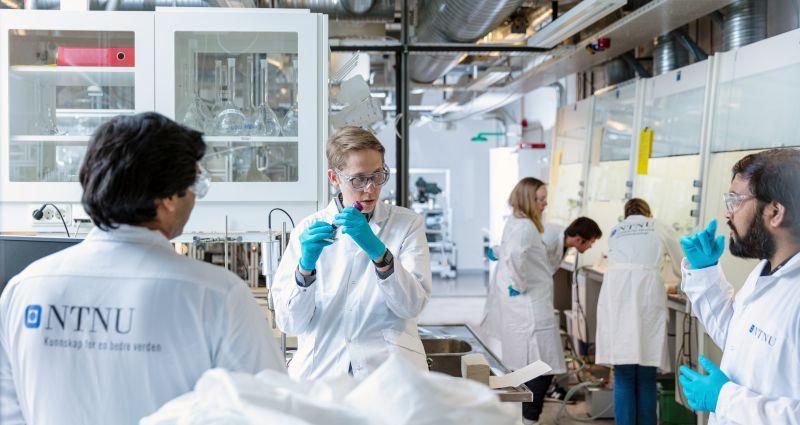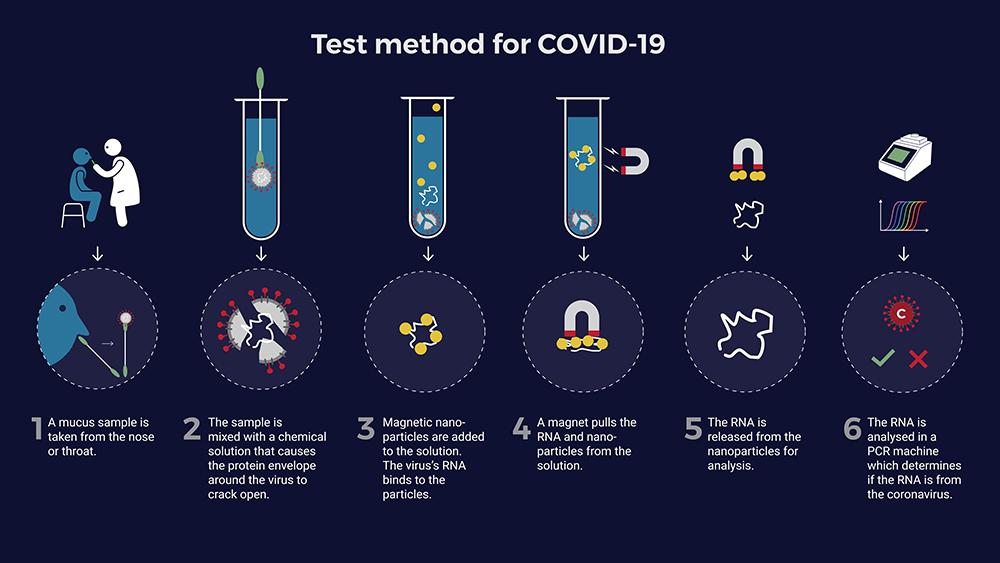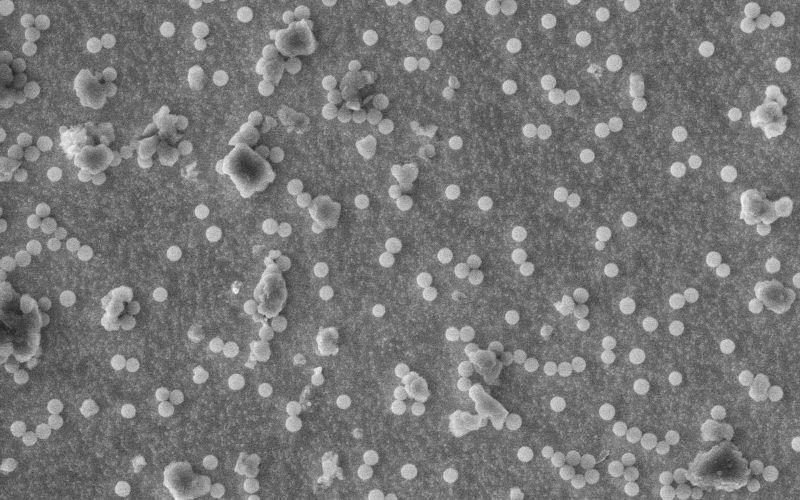COVID-19 test
NTNU COVID-19 test

Photo: Geir Mogen/NTNU
Why NTNU developed a new test method
After several weeks of intensive testing for the coronavirus, St. Olavs hospital in Trondheim was running out of test equipment.
To prevent a shortage of test materials, as well as limit the country’s dependence on commercial sources for test equipment, researchers from NTNU’s Department of Clinical and Molecular Medicine and the Department of Chemical Engineering teamed up to develop their own test method.
The result is a new method based on known processes, that uses an in-house chemical mix and NTNU-crafted magnetic nanoparticles. Preliminary results indicate that the NTNU test is at least as sensitive compared to the best methods on the market.
How does the new coronavirus test work?

The coronavirus test involves several steps:
- A sample is taken from nose and/or throat.
- The sample is mixed with a chemical solution that causes the protein envelope around the virus to crack open so that the virus's RNA (genetic material) is released.
- The sample is then mixed with magnetic nanoparticles to which the coronavirus RNA binds.
- The magnetic nanoparticles, covered with RNA, are extracted from the solution with a magnet.
- RNA is released from the nanoparticles by adding water.
- A standard PCR analysis determines if the sample contains coronavirus RNA.
Here’s how NTNU developed an effective coronavirus test

Photo: Electron microscope image taken by NTNU NanoLab, April 2020.
1. Researchers optimized a process to identify small amounts of the coronavirus
An RNA molecule is essentially the genetic material from the coronavirus. The RNA molecules of the virus are protected by a protein envelope and are closely surrounded by other molecules. That means when a sample is taken from someone infected with the virus, the first challenge is to "unpack" the virus's RNA so that it can be analysed.
NTNU has developed a specific combination of polar solvents, buffers, salts and other chemicals to achieve this without damaging the RNA molecule itself. NTNU researchers were able to optimize this combination to extract RNA from small amounts of virus.
2. Magnetic nanoparticles efficiently capture RNA from the coronavirus
Once the RNA molecules have been liberated from the virus, they must be extracted from the solution for analysis. The NTNU test uses iron oxide magnetic nanoparticles covered with a substance that strongly binds RNA. Once the magnetic nanoparticles are coated with the viral RNA, they can be removed from the solution using a magnet.
NTNU has developed and filed patent applications on an upscalable process for producing these high-quality, high-performance magnetic nanoparticles. The newly developed technology allows the NTNU lab to produce particles for roughly 10,000 tests in one production cycle. The process can then be further scaled up by running several production lines in parallel. Today, NTNU can produce 1,2 million tests per week. It is possible to scale up this process even further.
NTNU COVID-19 test provided to the Norwegian health care system
NTNU has been commissioned by the Norwegian Directorate of Health to provide COVID-19 tests for Norway’s health care system.
The COVID-19 tests will be used to test:
- health professionals with symptoms or who have been exposed to infection
- especially vulnerable people in the population
The Norwegian Institute for Public Health and the Directorate of Health will continuously update the status of testing and future plans here.
The hope is that the newly developed test will mean that access to tests will no longer be a limiting factor in the ability of the Norwegian health care system to test for the coronavirus.
Press contacts
Nancy Bazilchuk – international media
+47 918 97 321 / nancy.bazilchuk@ntnu.no
Idun Haugan – national media
+47 922 62 889 / idun.haugan@ntnu.no
Contact NTNU Technology Transfer
Tonje S. Steigedal
+47 905 52 334 / tonje.s.steigedal@ntnu.no
Eivind Andersen
+47 900 30 570 / eivind.andersen@ntnu.no
Multidisciplinary team:
Researchers from three different departments at NTNU have been involved in the development of the new test. St. Olavs hospital has also been an important contributor.
NTNU’s collaboration on the COVID-19 test is a good example of how new connections from different professional environments can help to solve social challenges in an effective way.
Department of Chemical Engineering
Department of Materials Science and Engineering
Department of Clinical and Molecular Medicine
-
Per Arne Aas Senior Engineer
+47-73598441 +4799788603 +4772573072 per.a.aas@ntnu.no Department of Clinical and Molecular Medicine -
Magnar Bjørås Professor
+47-73598474 +4795081497 magnar.bjoras@ntnu.no Department of Clinical and Molecular Medicine -
Sten Even Erlandsen Chief Engineer
+47-73598495 +4741499722 sten.e.erlandsen@ntnu.no -
Lars Hagen General Manager of PROMEC
+47-73598508 +4772573342 lars.hagen@ntnu.no Department of Clinical and Molecular Medicine
Department of Microbiology, St. Olav’s Hospital
Janne Fossum Malmring, Senior biomedical laboratory scientist
NTNU articles on COVID-19
- Not enough COVID-19 tests? No problem, we'll make them!
- Testing larger households can reduce coronavirus infections in Norway
- From thousands of tiny magnetic balls to 150,000 COVID-19 tests per week
- Fast-moving information on a fast-moving virus
- 3D printing team improves personal protection equipment for hospitals
- Existing drugs may offer a first-line treatment for coronavirus outbreak
